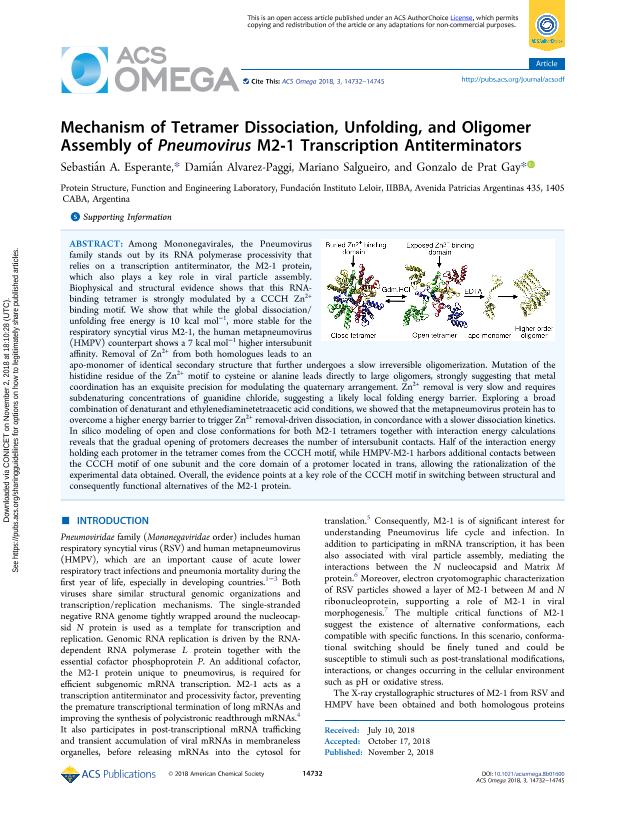Artículo
Mechanism of Tetramer Dissociation, Unfolding, and Oligomer Assembly of Pneumovirus M2-1 Transcription Antiterminators
Fecha de publicación:
11/2018
Editorial:
American Chemical Society
Revista:
ACS Omega
ISSN:
2470-1343
Idioma:
Inglés
Tipo de recurso:
Artículo publicado
Clasificación temática:
Resumen
Among Mononegavirales, the Pneumovirus family stands out by its RNA polymerase processivity that relies on a transcription antiterminator, the M2-1 protein, which also plays a key role in viral particle assembly. Biophysical and structural evidence shows that this RNA-binding tetramer is strongly modulated by a CCCH Zn2+ binding motif. We show that while the global dissociation/unfolding free energy is 10 kcal mol-1, more stable for the respiratory syncytial virus M2-1, the human metapneumovirus (HMPV) counterpart shows a 7 kcal mol-1 higher intersubunit affinity. Removal of Zn2+ from both homologues leads to an apo-monomer of identical secondary structure that further undergoes a slow irreversible oligomerization. Mutation of the histidine residue of the Zn2+ motif to cysteine or alanine leads directly to large oligomers, strongly suggesting that metal coordination has an exquisite precision for modulating the quaternary arrangement. Zn2+ removal is very slow and requires subdenaturing concentrations of guanidine chloride, suggesting a likely local folding energy barrier. Exploring a broad combination of denaturant and ethylenediaminetetraacetic acid conditions, we showed that the metapneumovirus protein has to overcome a higher energy barrier to trigger Zn2+ removal-driven dissociation, in concordance with a slower dissociation kinetics. In silico modeling of open and close conformations for both M2-1 tetramers together with interaction energy calculations reveals that the gradual opening of protomers decreases the number of intersubunit contacts. Half of the interaction energy holding each protomer in the tetramer comes from the CCCH motif, while HMPV-M2-1 harbors additional contacts between the CCCH motif of one subunit and the core domain of a protomer located in trans, allowing the rationalization of the experimental data obtained. Overall, the evidence points at a key role of the CCCH motif in switching between structural and consequently functional alternatives of the M2-1 protein.
Palabras clave:
antiterminador
,
pneumovirus
,
oligomerizacion
,
proteina
Archivos asociados
Licencia
Identificadores
Colecciones
Articulos(IIBBA)
Articulos de INST.DE INVEST.BIOQUIMICAS DE BS.AS(I)
Articulos de INST.DE INVEST.BIOQUIMICAS DE BS.AS(I)
Citación
Esperante, Sebastian; Álvarez Paggi, Damián Jorge; Salgueiro, Mariano; de Prat Gay, Gonzalo; Mechanism of Tetramer Dissociation, Unfolding, and Oligomer Assembly of Pneumovirus M2-1 Transcription Antiterminators; American Chemical Society; ACS Omega; 3; 11; 11-2018; 14732-14745
Compartir
Altmétricas




